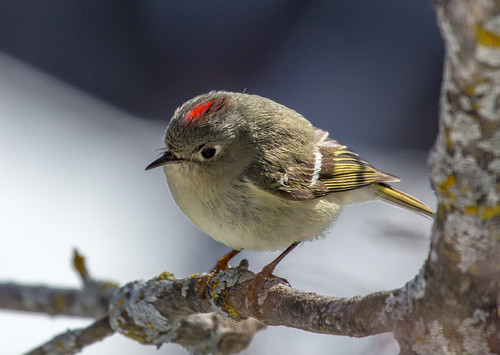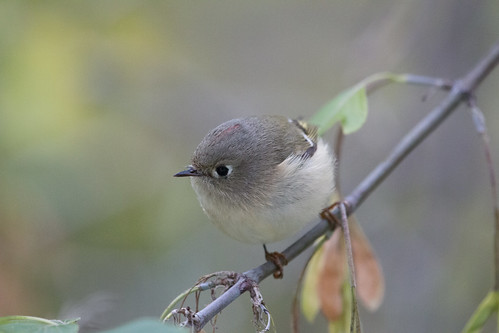On September 3, 1975, I went to the Flag River in Port Wing,
Wisconsin, with my father-in-law. He was fishing, and I was searching for
birds. I’d started birding just 6 months before, and that very September day
I’d broken 100 on my life list. Now, while he was casting for trout, I spotted
a tiny bird flitting about. It was the most active bird I’d ever seen
before—not just flitting from branch to branch, but during the second or two
when it sat in the same spot, it kept restlessly flicking its wings. There may
actually have been a small group of them, this being migration, but I kept
looking back and forth between a restless little bird (maybe the same individual, maybe not) and my field guide
trying to figure out what it was. I tried to see every single field mark
possible. In this case, I absolutely needed to see the ruby crown that
gives the Ruby-crowned Kinglet its name. It took at least 10 minutes, maybe more, before I got a
momentary glimpse of that.
As it turned out, the eye ring, tiny size, and restless
habit of flicking its wings would have been enough to clinch the
identification, but I’ve always been proud of having seen that field mark in
fall, when they are least likely to be raising their head feathers to show it.
The Ruby-crowned Kinglet was #102 on my life list.
The following spring I learned the kinglet’s song, which
quickly became one of my all-time favorites. And after I knew the song, I
discovered that Ruby-crowned Kinglets were extremely common during spring and
fall migration, everywhere I birded, and turned up here and there, except in
the northernmost areas where I birded regularly, in winter. But I had virtually
no experiences with them in summer, only once hearing one on my Breeding Bird
Survey route.
Thomas Sadler Roberts never established that they nested in
Minnesota at all until the 1930s, and they weren’t considered a regular
breeding species in the state until the 40s. They are known to nest in North
Star, Fredenberg, and Gnesen Townships outside Duluth, but only in very
forested areas, not right in town. And we’ve had no nesting records within
Duluth itself ever.
The preliminary results of Minnesota’s Breeding Bird Atlas
include 13 confirmed blocks for nesting along with an additional 391 blocks of
probable or possible nesting, none very close to Duluth itself.
No summer records of Ruby-crowned Kinglet in Wisconsin exist
before the 1940s. During the 40s, summer records were documented in 5 counties,
but no nests were found in the state until Tom Soulen discovered one in Oneida
County in 1964. Sam Robbins noted in his Wisconsin
Birdlife that they are restricted to tamarack and black spruce bogs.
The first Wisconsin Breeding Bird Atlas, conducted from
1995 through 2000, confirmed nesting in 17 atlas blocks (1.5 percent of all the
blocks in the state), and found probable or possible nesting in an additional
57 blocks. The birds documented in Wisconsin's first Atlas program were found in lowland
coniferous forests, as Robbins noted, or in upland mixed forests composed
primarily of white spruce or balsam fir and hardwoods, the nests usually in
spruce trees, but high enough to be very hard to see. No nests have been found in towns or cities in Wisconsin, either.
All this seemed important in the abstract to me until this
year, when suddenly I took a a more personal interest in Ruby-crowned Kinglets.
As I said, I hear them in my backyard every single spring, with a lot of
frequency. I had my first in my yard on April 15, about on time for a fairly
early spring like we had this year. I did a lot of traveling from mid-April
through May, but heard them frequently when I was home. It seemed a little odd
to still have them singing at the end of the month, but I was still getting
plenty of migrating warblers, so I didn’t think about it being anything out of
the ordinary.
I wasn’t home on June 1, but on June 2 I still had one—the
first June experience with the species singing I ever had except that one time on my Breeding Bird
Survey, well away from town. So I started paying attention. I was home almost
every day of June, and every single day I was home, I heard the Ruby-crowned
Kinglet singing away. That continued not only through June 30, but into July,
through the fifth, and a few times since.
I’ve not been able to locate a nest, and the birds
themselves have been almost impossible to locate even when I can hear the male singing away—the best I’ve done is to occasionally see one flitting through dense foliage high up in
the trees.
But finally, last week, after hearing the male singing and searching
through the branches of my neighbor’s big maple, I got a glimpse of a Ruby-crowned Kinglet carrying food. That counts as confirmation of nesting by Breeding Bird Atlas
rules—the first ever in the city of Duluth, so my little singer turns out to be
a pretty significant guy, which makes me a pretty happy birder.

